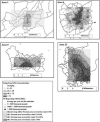Associations of estimated residential soil arsenic and lead concentrations and community-level environmental measures with mother-child health conditions in South Carolina
- PMID: 22579118
- PMCID: PMC4667965
- DOI: 10.1016/j.healthplace.2012.04.005
Associations of estimated residential soil arsenic and lead concentrations and community-level environmental measures with mother-child health conditions in South Carolina
Abstract
We undertook a community-level aggregate analysis in South Carolina, USA, to examine associations between mother-child conditions from a Medicaid cohort of pregnant women and their children using spatially interpolated arsenic (As) and lead (Pb) concentrations in three geographic case areas and a control area. Weeks of gestation at birth was significantly negatively correlated with higher estimated As (r(s) = -0.28, p = 0.01) and Pb (r(s) = -0.26, p = 0.02) concentrations in one case area. Higher estimated Pb concentrations were consistently positively associated with frequency of black mothers (all p < 0.02) and negatively associated with frequency of white mothers (all p < 0.01), suggesting a racial disparity with respect to Pb.
Copyright © 2012. Published by Elsevier Ltd.
Figures


References
-
- Aelion CM, Davis HT. Use of a general toxicity test to predict heavy metal concentrations in residential soils. Chemosphere. 2007;67:1043–1049. - PubMed
Publication types
MeSH terms
Substances
Grants and funding
LinkOut - more resources
Full Text Sources
Medical
Research Materials

